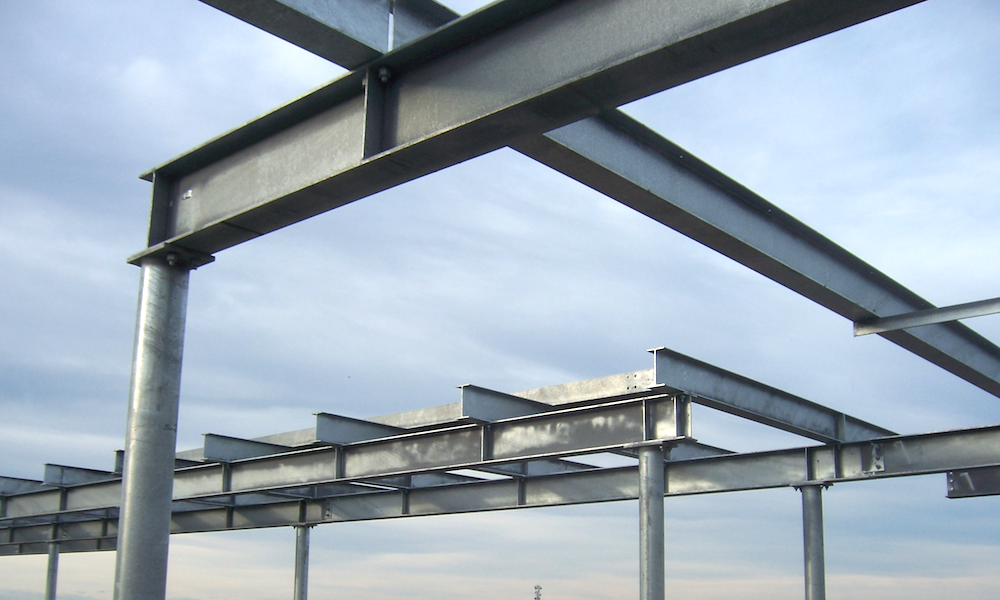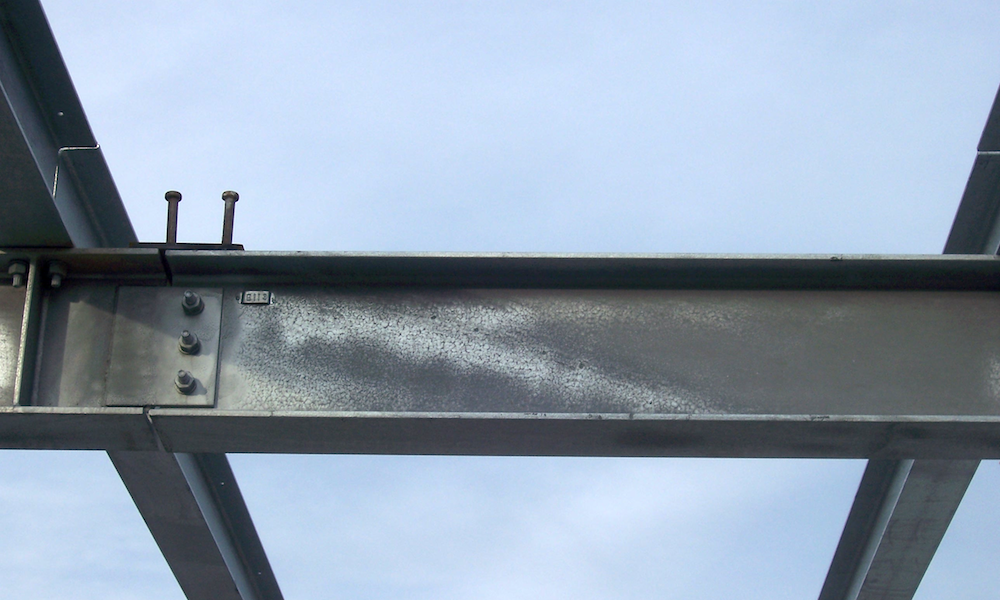We use uncoated galvanized steel as a sustainable finish in many of our projects. It is sustainable because galvanizing produces a durable, no maintenance finish with a sixty-year plus lifespan. Recently we have noticed that its appearance can be less uniform than we have seen on previous projects.
This material is sustainable because galvanizing produces a durable, no maintenance finish with a sixty-year plus lifespan.
The galvanized coating on steel is both protective and decorative. ASTM A123 Zinc (Hot Dip Galvanized) Coatings on Iron and Steel is the industry standard for specifying typical galvanized steel coatings. This specification focuses on the protection from corrosion (cathodic protection) afforded by galvanized steel. Many factors affect the APPEARANCE of galvanized steel, but do not reduce protection from corrosion.
The support structure for the rooftop photovoltaic array at our 7th and H project provides an example of adequate cathodic protection, yet a problematic appearance if the structure was located in a highly visible location.
During the pre roofing conference held on January 24, 2012, the PV support structure was observed to have a very un-uniform galvanized finish appearance. Portions were dark dull gray while other portions of the same I beam were shiny.
The PV array support structure is acceptable, but Mogavero is concerned that the appearance of the galvanized finish on the second floor terrace gazebos will not be as intended unless this appearance is not addressed by the galvanizer. The galvanizer should be made specifically aware that finish is an important part of the design and that steps need to be taken to ensure a more uniform finish with a natural reflectivity range of 70% or greater.
My research indicates that there are several potential causes and remedial steps to ensure a more uniform finish.
The following comments are based upon research conducted at the American Galvanizers Association. Galvanized coating is created in several layers, the surface (or “zeta: layer) grows in columns perpendicularly outward from the base steel. It appears that the surface layer of the zinc coating (zeta layer) is overgrown (too thick) in the dull areas and thinner in the shiny areas. My research indicates that there are several potential causes and remedial steps to ensure a more uniform finish.
Steel chemistry
Steel with chemistry outside the recommended limits and ranges for galvanizing is known as “reactive steel.” This steel may have higher levels of phosphorous and silicon than is appropriate for an exposed galvanized surface. Steel Mil Certificates indicating phosphorous and silicon content may not be a reliable indicator as the certificates are generally an average of sample pieces and do not necessarily reflect the actual chemistry of each part. The galvanizer should specify steel phosphorous and silicone limits within optimum galvanizing tolerances. The galvanized coating is created through a metallurgical reaction between the steel and the zinc in the galvanizing kettle. For non-reactive steel, the metallurgical reaction is complete within six or seven minutes. After that time, no additional zinc is deposited on the steel. For reactive steel, the coating experiences linear growth with respect to the time it is exposed in the galvanizing tank: the longer reactive steel is left in the galvanizing tank, the thicker the coating.
Adding nickel to the galvanizing bath
Nickel can be added to the galvanizing bath to help control reactive steels by reducing intermetallic formation. This process is effective as long as the steel has 0.20% silicone content or less. Tin and aluminum can also be added to the galvanizing bath to produce a better overall appearance.
Cooling time
During hot-dipped galvanizing, the steel is heated to approximately 830 degrees F. Reactive steel continues reacting as long as there is free zinc available and the temperature is 500 degrees F or higher – even when outside the galvanizing bath. This happens when reactive steel on thick, heavy parts is cooled slowly. If the reactive steel consumes the entire eta layer, the zeta intermetallic layer will grow to the surface and will transform the part from shiny to dull as the part cools. When steel is dipped into a quench tank immediately after galvanizing, the temperature of the steel drops several hundred degrees quickly; thus stopping the metallurgic reaction. Quench options include water, chromate and phosphate.
Withdrawal speed
Withdrawal speed can affect the thickness of the galvanized coating. The faster steel is removed from the galvanizing kettle, the less zinc is able to drain off the steel before solidifying. This means faster withdrawal rates can create thicker coatings.
Blasting
Blasting is a process whereby abrasive particles are propelled at the steel surface using compressed air. Blasting interferes with the growth of the zeta layer, rather than growing in long columns when the surface is flat. Blasting creates many peaks and valleys so the growing crystals collide and interfere with each other to the point that they cannot continue to grow. The American Galvanizers Association comments that “Blasting is not a replacement for sourcing steel with the recommended chemistry; however, in those times when you must galvanize reactive steel, blasting can help decrease the coating thickness.”
Specifications
The specifications should make the intent clear to the Galvanizer. For example:
- FINISH
- Galvanizing: Hot-dip process ASTM A385-11 (exposed sunshades and trellises) ASTM A123 (concealed locations) typical and ASTM A153 for threaded fasteners performed after fabrication into largest practical section. Weight of coating not less than 2 oz. per sq. ft. of surface. Where damaged, repair surface with one coat of hot process galvanizing repair compound, “Galvalloy”, Galvweldalloy”; or equal.
- Exposed galvanized fabrication, not scheduled to be field painted shall present a uniform visual appearance.
- Do not use reactive steel as defined by the A6A.
- If reactive steel is used as a component, the galvanizer is responsible to take such measures as are required to assure a uniform appearance.Measures may include:
- Blasting steel prior to galvanizing
- Adding nickel tin or aluminum to the galvanizing bath
- Quenching galvanized components to shorten cooling time
- Limiting the time the steel is in the galvanizing bath.
- Exposed galvanizer fabrication exhibits excessive variation in finish appearance including color, reflectance or dross inclusions as determined by the Architect shall be rejected.
- Exposed galvanized hand nails exhibiting rough (not smooth) finish including dross inclusion or other deposits shall be rejected.
Conclusion
It is critical that the Architect inform the galvanizer to the importance of the visual surface appearance at the second floor terrace gazebos and develop an action plan to assure the final result is as intended. Action plan may include all or some of the following:
- Specify and obtain non-reactive structural steel.
- Adding nickel or other elements to the galvanizing bath.
- Limit time the steel is immersed in the galvanizing bath.
- Quench the steel for rapid cooling.
- Slow withdrawal speed to maximize zinc runoff, then quench to cool.
- Blasting the steel prior to galvanizing.
One additional item: the American Galvanizer’s Association web site notes concern that adequate drain holes and vent holes be provided to allow galvanizing the interior of capped tube steel members. Gusset plates may need to be cropped (would require the approval of the Structural Engineer) to ensure unimpeded flow of the galvanizing solution. These features were not included in the gazebo shop drawings. The galvanizer should review the shop drawings and provide input prior to fabrication.



Often we clean up hot dipped with a wire brush on a grinder. It kinds of smears the coating without removing it. Does your spec fall under AESS?
I have researched AES Guidelines. There is excellent information on cutting, fitting, cleaning up welds, and finnishes, except galvanizing – there needs to be standards developed to consider galvanizing as BOTH a protective element AND a beautiful, sustainable finish. I am thinking that the Steel Industry may not be receptive to the chemical composition quality control that appears to be necessary to provide non-reactive steel necessary to create uniform appearing galvanized finishes. Note: the columns are beautiful with nice blooms (I think that’s the correct name for the crystalline spangle seen in some galvanized surfaces) and very uniform while the steel beams have a streaky appearance. I was up on the roof last week and the contrasts seem to be slightly mellowing out.
Though not specific to AESS, the standard specification for hot dipped galvanized of iron and steel products is ASTM A123; further, ASTM A385 provides a standard practice for High-Quality Zinc Coatings. I recommend that you locate those documents, both of which offer some background on appearance; and, I believe what you are referring to as “blotchy” is discussed in A385 clause 3 as “mottled or dull gray in appearance”. Per ASTM, this is a result of the steel chemistry and the reaction between the steel and the molten zinc. Clause 3.6 states in part, “ In general, galvanized coatings are specified because of their corrosion resistance, not because of their appearance.”
Sincerely,
Erin Criste, LEED Green Assoc.
Staff Engineer
American Institute of Steel Construction
866.ASK.AISC
hm/eng
Thank you. That is very helpful!
I have recently learned that many galvanized items come from overseas and are protected with a passivator to combat the effects of salt spray. The passivator can not be removed like normal mill scale and will prevent paint from sticking unless it is removed. Chemical methods have resulted in problematic results at best. The American Galvanizing Association recommends SSPC-SP7 brush-off blast cleaning as the only effective and approved method to remove this coating.
The presence or absence of a passivator can be checked using a 3% copper sulfate solution applied to the galvanized metal – if the metal discolors, the passivator is either absent or has been removed.
If we are staying with painted galvanized metal I recommend we write a memo to General Contractors we work with alerting them to the issues and recommending requiring their steel fabricator subcontractor to make sure there is no passivator present on galvanized items to be painted prior to delivery to the project site.
Thank you for the interesting article about galvanized steel. I actually didn’t know that nickel could be added to help control reactive steels. I’m kind of interested to learn if the amount of nickel that should be added depends on how big the galvanizing bath is.
The article has great innovative techniques to improvise the Galvanize coating techniques and make the outcome more qualitative and appealing. I want you to thank you for sharing this creative information on steel coating such improvisation results in better quality and raising the standard of the product in the market. Great Thoughts!
Its good website. Thanks for giving full information about Galvanizes Rolling Shutters. You can also see at makautomaticdoors.com